Landmine Monitor 2019
Support for Mine Action
Article 6 of the Mine Ban Treaty on international cooperation and assistance recognizes the right of each State Party to seek and receive assistance from other States Parties in order to fulfill its treaty obligations. This chapter focuses on financial support for mine action provided for calendar year 2018 by affected countries and international donors. Cooperation and assistance, however, is not only limited to financial assistance. Other forms of assistance can include the provision of equipment, expertise, and personnel, as well as the exchange of experience, know-how, and best-practice sharing.
2018 Figures and Trends
Total Support to Mine Action—Thirty-three donors and eight affected states reported contributing US$699.5 million in international and national support for mine action in 2018[1]; this is $95.1 million less than the revised 2017 amount (a 12% decrease).
International contributions accounted for 92% of overall support for mine action in 2018, while states’ contributions to their own national mine action programs accounted for the remaining 8% of global funding.
International Contributions—After two years of sustained growth in 2016 and 2017, the level of international support for mine action provided by donors declined from $696.3 million in 2017 to $642.6 million in 2018 (an 8% decrease). This represents the second-highest level of international support recorded by the Monitor.[2]
- The majority of the funding came from just a few donors, with the top five donors—the United States (US), the European Union (EU), the United Kingdom (UK), Norway, and Germany—contributing a total of $458.1 million, or 71% of all international funding for 2018.
- The top five recipient states—Iraq, Afghanistan, Syria, Croatia and Lao PDR—received a combined total of $351.2 million, representing 55% of all international contributions.
- International funding was distributed among the following sectors: clearance and risk education (62% of all funding), victim assistance (7%), capacity-building (2%), and advocacy (1%). The remaining 28% was not disaggregated by the donors.
National Contributions—The Monitor identified eight affected states that provided $56.9 million in contributions to their own national mine action programs, down $41.4 million (a 42% decrease) from 2017 when 10 affected countries reported contributing $98.3 million.
International Contributions in 2018
In 2018, donors contributed more than $642 million in international support for mine action—a decrease of $53.7 million (8%) from the $696.3 million reported in 2017. While this halts the two-year in a row growth seen in 2016 and 2017, it is the second-highest level of funding recorded since 2008.[3]
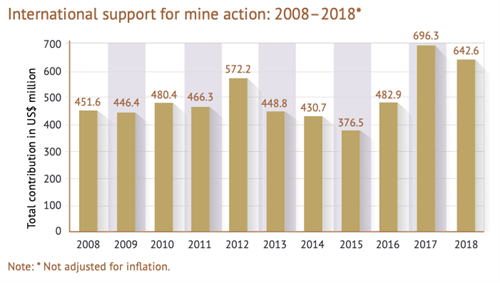
Donors in 2018
In 2018, 26 Mine Ban Treaty States Parties, three states not party, the EU, and three other institutions[4] contributed a total of $633.1 million to mine action.
A small group of donors continued to provide the majority of international mine action support with the five largest donors (the US, the EU, the UK, Norway, and Germany) accounting for nearly three-quarters (71%) of all international support with a combined total of $458.1 million. The US remained the largest mine action donor with $201.7 million and it alone provided nearly a third (31%) of all international mine action support in 2018. The EU ranked second with $108.1 million, or 17% of all contributions, while the next three donors—the UK, Norway, and Germany—provided more than $40 million each.
Another 10 donors contributed less than $1 million each, seven fewer compared to the 17 contributing donors in that range in 2017.
Support from States Parties in 2018 accounted for more than half of all donor funding, with 26 countries providing $322 million. This represents an 11% increase from the $288.9 million recorded in 2017.
In 2018, the EU and its Member States[5] contributed a total of $301.5 million and accounted for 47% of the total international support, up from the $244.5 million provided in 2017 (35% of the total international funding for that year).

Twenty donors contributed more in 2018 than they did in 2017, including a $40.5 million increase from the EU (60%), and a $31.4 million increase from the UK (117%). Additionally, Denmark, Norway, and Sweden increased their assistance by more than $7 million each. Two new donors were also identified in 2018: China and Cyprus.
In contrast, 11 donors decreased their funding, led by the US (down $118.9 million, a 37% decrease) and Germany (down $41.9 million, a 50% decrease).[7] Additionally, six donors from 2017 did not report any new contribution to mine action in 2018.
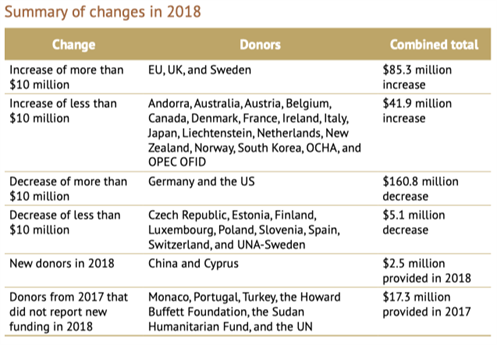
The table below summarizes the changes in mine action funding from the top 15 donors, expressed in their respective national currencies and US$ terms, and shows the impact of the exchange rates on the US dollar value of international contributions:
- In US dollar terms, mine action international support rose in 11 countries and the EU, with the biggest percentage increases recorded in Sweden (+258%), the UK (+117%), and Australia (98%). In national currency terms, increases were recorded in nine countries and the EU and in most instances, they were less pronounced (with the exception of Australia, New Zealand, and Sweden, where the increases were greater when expressed in national currency terms).
- Consequently, whereas five states reported decreases in their mine action contributions in 2018, after conversion into US dollars, these reductions were either smaller in percentage terms or reversed by a slight increase, as was the case for Canada and the Netherlands.
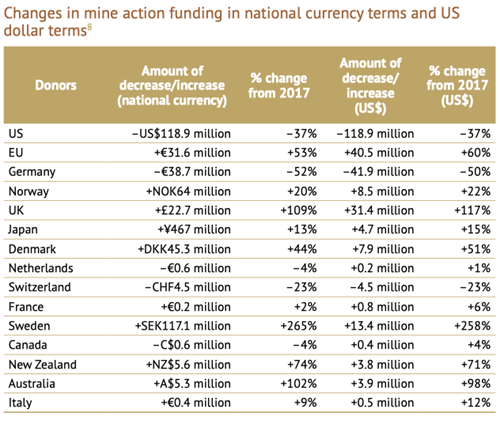
Funding Paths
Donors contributed to mine action through several trust fund mechanisms, notably the UN Voluntary Trust Fund for Assistance in Mine Action (VTF) administered by UNMAS and ITF Enhancing Human Security (established by the government of Slovenia and formerly known as the International Trust Fund).
In 2018, contributions through UNMAS totaled $99.8 million from 23 donors. Several small donors used the VTF to contribute to mine action.[9] At least five donors, as well as the OPEC Fund for International Development (OFID), allocated $2.4 million in 2018 through the ITF for mine action programs.
While donor funding is frequently used for national activities, implementation is often carried out by an array of partnering institutions, NGOs, trust funds, and UN agencies. Organizations that received a significant proportion of contributions in 2018 included Norwegian People’s Aid ($42.1 million), Mines Advisory Group ($37.1 million), HALO Trust ($35.8 million), the International Committee of the Red Cross (ICRC) ($32 million), DanChurchAid ($26.6 million), Humanity & Inclusion ($11.9 million), and the Geneva International Centre for Humanitarian Demining ($11.4 million).
Recipients
A total of 43 states and three other areas received $569.7 million from 31 donors in 2018. A further $72.9 million, designated as “global” in the table below, was provided to institutions, NGOs, trust funds, and UN agencies without a designated recipient state or area.
As in previous years, a small number of countries received the majority of funding. The top five recipient states—Iraq, Afghanistan, Syria, Croatia, and Lao PDR—received 55% of all international support in 2018.
Iraq received the largest amount of funding (18% of all international support) from the largest number of donors (18). Fifteen states and one area, or 35% of all recipients, had only one donor.[10]
More than two-fifths of international support (44%, or $281.5 million) went to 10 countries and one other area with massive contamination.[11] Most of this funding went to clearance and risk education projects.
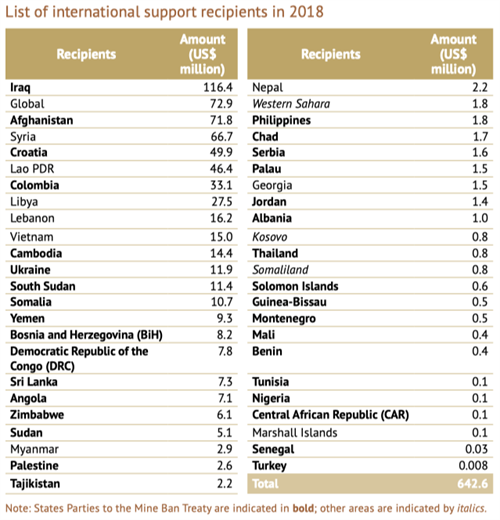
In 2018, 32 states and areas experienced a change of more than 20% in funding compared to 2017, including 18 recipients receiving more support, and 14 recipients receiving less support, two of which received no support. These fluctuations may reflect shifts in donor priorities and changes in local situations.
Afghanistan and Croatia were the recipients with the largest increases, receiving respectively $29.5 million and $37.1 million more than in 2017, notably following the increases in the contributions of the US and Germany as previously detailed. In addition, two countries saw a substantial increase in support received: Lebanon ($9.4 million more) and Lao PDR ($7.2 million more).
- Support to Afghanistan ($71.8 million) increased by 70% in 2018. OCHA provided $4.8 million to support mine action activities via UNMAS. Three donors considerably increased their contributions compared to 2017: the UK ($16.4 million more), the Netherlands ($4.4 million more), and Germany ($2.4 million more).
- Support to Croatia jumped from $12.9 million in 2017 to $37.5 million in 2018, following the awarding of EU funding to support clearance activities. The EU was Croatia’s sole international donor in 2018.
- Support to Lebanon ($16.2 million) more than doubled from 2017. This was due to the increase in the US contribution ($4 million provided in 2018 compared to $1.5 million in 2017), the EU ($5.3 million provided in 2018) and the UK ($1.4 million provided) in order to support clearance and risk education operations.
- Support to Lao PDR ($46.4 million) increased by nearly one-fifth in 2018, following increases in funding from Japan (about $10 million more than in 2017), and the UK ($1.3 million more than in 2017).
Iraq was the recipient with the largest decrease, receiving $86.9 million less than in 2017. Three additional countries experienced a high-value decline in support received in 2018: Colombia ($35.3 million less), Syria ($26.2 million less), and Chad ($24 million less). These decreases were the result of changes in donors’ contributions:
- Support to Chad in 2018 ($1.7 million) was 93% lower than funding in 2017, primarily due to a decline after massive EU contributions to support clearance activities with $25.7 million provided in 2017.
- Support to Colombia ($33.1 million) was reduced by more than half in 2018. The drop was mainly due to no new contributions reported by Japan ($9.3 million provided in 2017) and the Howard Buffett Foundation ($16.1 million provided in 2017). However, Colombia was the sixth largest country-recipient of mine action support.
- Support to Iraq and Syria respectively dropped by 43% and 28%, as was expected after the massive contributions reported by Germany and the USA in 2017. Support to Iraq in 2018 marked the return to a level of funding closer to that reported in 2016 ($79.7 million).
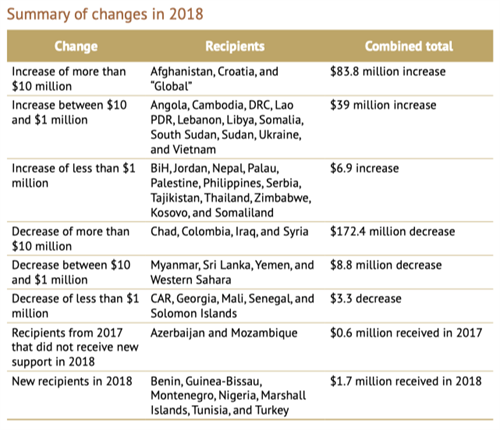
Funding by Thematic Sector
In 2018, 62% of mine action funding supported clearance and risk education activities, while support to victim assistance represented 7% of the total international support to mine action.
“Various” funding represented 28% of all international support to mine action. This includes contributions not disaggregated by the donors, as well as funding not earmarked for any sectors.

Note: N/A = not applicable. “Dedicated contribution” (non-various funding) totaled $460million in 2018 and included funding set for a specific sector (advocacy, capacity-building, clearance, risk education, stockpile destruction, or victim assistance). The “0” in stockpile destruction in 2018 does not mean states expended no funds for that activity, but rather that none of the contributions reported in 2018 detailed dedicated stockpile destruction funding.
Clearance and risk education
In 2018, $396.9 million, or 62% of all reported support for mine action, went toward clearance and risk education activities. This represents a decrease of $7.4 million from 2017.
Four of the 10 largest donors—the US, the EU, the UK, and Norway—provided three-quarters of all support to clearance and risk education ($293.5 million).
Many donors reported clearance and risk education as a combined figure. Twenty-one donors did, however, indicate contributions specifically for clearance activities, providing a total of $123.1 million in 29 countries and two other areas.[13]
Twelve donors reported contributions totaling $9.3 million specifically for risk education projects in 16 countries.[14] Syria received the most risk education-specific funding with $2.7 million.
Victim assistance
Based on information available as of October 2019, direct international support for victim assistance activities in 2018 totaled $44.7 million, up from $27.7 million in 2017, and represented 7% of all reported support for mine action. While this represents an increase of $17 million (up 61%) compared to 2017, as a proportion of all international support provided this remains within the 4–7% range observed since 2013.
Sixteen[15] donors reported contributing to victim assistance projects in 12 States Parties, and five states not party.[16] Most mine-affected countries did not receive any direct international support for victim assistance. The 2018 increase was the result of higher contributions from donors to victim assistance activities within the context of emergency operations in conflict-affected countries in the Middle East and Afghanistan. However, there was a continuous and sharp decline in victim assistance support provided for most of the other affected countries where needs remain great and available resources are lacking, with nine out of the 17 recipients receiving less support in 2018 compared to 2017 (for a combined decrease totaling $11million).
The top three victim assistance donors—the US, Germany, and New Zealand—provided 70% ($31.2 million) of all victim assistance funding in 2018.
In 2018, nearly half of all victim assistance support (48%) went to just four countries—Iraq, Afghanistan, Yemen, and Syria— receiving a combined total of $21.7 million. Thirty percent was provided to global activities (without a designated recipient state or area), and the remaining 22% went to victim assistance activities in 13 other countries.
Funding for victim assistance activities remains especially difficult to track because many donors report that they provide support for victims through more general programs for development and for the rights of persons with disabilities, or are not able to provide specific details on dedicated victim assistance funding. Since such contributions are not disaggregated, it is not possible to include them in Monitor reporting. However, this annual estimate still provides an informative picture of the global victim assistance funding situation.
Advocacy and capacity-building
In 2018, just 1% of all reported support for mine action went toward advocacy activities ($4.4 million).[17] Of the 32 donors reporting international contributions to mine action, 13 reported supporting advocacy activities.
Fifteen donors collectively provided $14 million—2% of all international support—to support capacity-building activities in 15 countries.[18]
National Contributions in 2018
Overall national contributions to mine action continue to be under-reported. Few States Parties report national funding in their annual Article 7 reports. States Parties such as Iraq and Sri Lanka, as well as states not party India and Vietnam—all mine-affected states with significant contamination and major clearance operations, usually conducted by the army—have never reported annual expenditures.
Eight affected states reported $56.9 million in contributions to mine action from their national budget in 2018, $41.4 million less than the $98.3 million reported in 2017, and far from the $131.2 million reported in 2015.
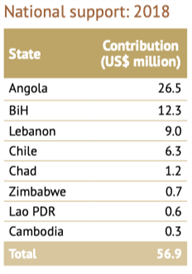
Five-Year Support to Mine Action 2014–2018
Over the past five years (2014–2018), total support to mine action amounted to $3.2 billion, an average of about $639 million per year.
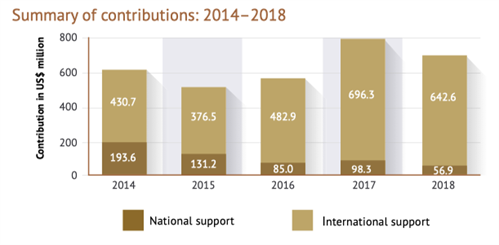
Although data about national support remains incomplete, such support has accounted for about 18% of total mine action funding over the period and amounted to approximately $565 million.
International support totaled $2.6 billion, an average of $525 million per year, and represented 82% of all support. Three donors—the US ($947.1 million), the EU ($361.8 million), and Japan ($208.8 million)—contributed $1.5 billion, nearly half of total international support. Four other donors—Germany, the Netherlands, Norway, and the UK—contributed more than $100 million each.
Between 2014 and 2016, there were notable variations in allocations of international support:
- Dedicated clearance and risk education funding increased by 40%: rising from $283.5 million in 2014 to nearly $397 million in 2018. Over the period, more than three-fifths of international support went to clearance and risk education activities (64%, or $1.8 billion).
- The volume of victim assistance funding totaled $139.1 million and has grown from $26.5 million in 2014 to $44.7 million in 2018 (an increase of 6%). However, support to victim assistance accounted for just 5% of all international support over the period.
- “Various” funding increased by about $110 million (150%) from $73 million to $182.6 million. In 2014, unearmarked and not disaggregated funding represented just 17% of all international support, compared to 35% in 2017 and 28% in 2018.
- Capacity-building remained more or less at the same level during the period with an average annual contribution of $11.6 million.
- International support to advocacy activities dropped significantly from $30.7 million in 2014 to $2.2 million in 2015 (a 93% decrease) and has remained below $5 million since.
- Donors did not report any new dedicated stockpile destruction funding since 2016.

[1] This figure represents reported government contributions under bilateral and international programs for calendar year 2018, as of October 2019. All dollar values presented in this chapter are expressed in current US dollars. Mine action support includes funding specifically related to landmines, cluster munitions, explosive remnants of war (ERW), and improvised explosive devices (IEDs) but is rarely disaggregated as such. State reporting on contributions is varied in the level of detail and some utilize a fiscal year rather than the calendar year. The total amount of international support in 2017 was updated to include revised contributions from France and the United States (US).
[2] The Monitor maintains records of international support to mine action back to 1996, and national support back to 2002.
[3] Data for 2018 on international support to mine action is based on reviews of Mine Ban Treaty Article 7 Reports, Convention on Cluster Munitions Article 7 Reports, Convention on Conventional Weapons (CCW) Amended Protocol II Annual Reports, ITF Enhancing Human Security Annual Report 2018, UNMAS Annual Report 2018, and answers from donors to questionnaires. Ten of the 26 States Parties documented in this chapter reported international funding for mine action in a Mine Ban Treaty Article 7 report for 2018, compared to 13 out of 28 States Parties in 2017.
[4] China, South Korea, and the US are the three states not party. The three institutions are the Organization for the Petroleum Exporting Countries (OPEC) Fund for International Development (OFID), the United Nations Association (UNA)-Sweden, and the UN Office for the Coordination of Humanitarian Affairs (OCHA).
[5] Eighteen EU Member States provided funding in 2018: Austria, Belgium, Cyprus, Czech Republic, Denmark, Estonia, Finland, France, Germany, Ireland, Italy, Luxembourg, the Netherlands, Poland, Slovenia, Spain, Sweden, and the UK.
[6] The amount for each donor has been rounded to the nearest hundred thousand. The total amount of international support for 2017 was updated as a result of revised France and US funding totals.
[7] These declines followed unusually large 2017 totals and were thus expected. At the Landmine Monitor briefing at the Seventeenth Meeting of States Parties, the US (from the floor) and Germany (from the panel) both stated that such exceptionally high funding would not be repeated annually. Nevertheless both countries were among the five largest donors in 2018. Landmine Monitor Briefing, Mine Ban Treaty Seventeenth Meeting of States Parties, Geneva, 26–30 November 2018.
[8] Average exchange rates for 2018: A$1=US$0.7481; C$1.1957=US$1; DKK6.3131=US$1; €1=US$1.1817; ¥110.4=US$1; NZ$0.6929=US$1; NOK8.1318=US$1; SEK8.6945=US$1; CHF0.9784=US$1; and £1=US$1.3363. US Federal Reserve, “List of Exchange Rates (Annual),” 2 January 2019, www.federalreserve.gov/releases/G5a/current/default.htm.
[9] The small donors included Andorra, Cyprus, Estonia, Liechtenstein, Poland, and Spain, as well as UNA-Sweden.
[10] Recipients with one donor included: Albania, Benin, Central African Republic, Chad, Croatia, Guinea-Bissau, Marshall Islands, Montenegro, Nepal, Nigeria, the Philippines, Senegal, Solomon Islands, Tunisia, Turkey, and other area Somaliland.
[11] Massive contamination is defined by ICBL-CMC as more than 100km². Recipients of international support with massive contamination included: Afghanistan, Angola, BiH, Cambodia, Chad, Croatia, Iraq, Thailand, Turkey, Yemen., and other area Western Sahara.
[12] In 2017, international support was distributed among the following sectors: clearance and risk education ($404.3 million, or 58% of total international support), victim assistance ($27.7 million, or 4%), capacity-building ($11.2 million, or 2%), advocacy ($3.6 million, or 1%), stockpile destruction ($0 million, or 0%), and various activities ($249.5 million, or 35%). Data for 2017 was revised—based on new figures that detailed dedicated clearance, risk education, and victim assistance funding, as well as contributions that were not previously reported by donors.
[13] States Parties recipients of international assistance for clearance were: Afghanistan, Angola, BiH, Cambodia, Colombia, Croatia, DRC, Iraq, Palau, Palestine, Senegal, Serbia, Somalia, South Sudan, Sri Lanka, Sudan, Tajikistan, Tunisia, Ukraine, Yemen, and Zimbabwe. Signatory that received international assistance for clearance was: the Marshall Islands. States not party that received international assistance for clearance were: Georgia, Lao PDR, Lebanon, Libya, Myanmar, Syria, and Vietnam. Other areas that received international assistance for clearance activities were: Kosovo and Somaliland.
[14] Recipients of international assistance for risk education were: CAR, Colombia, Iraq, Jordan, Lao PDR, Lebanon, Libya, Mali, Myanmar, Palestine, South Sudan, Syria, Thailand, Turkey, Ukraine, and Yemen.
[15] Victim assistance donors included: Andorra, Australia, Austria, Belgium, Czech Republic, EU, France, Germany, Italy, Japan, Liechtenstein, New Zealand, Norway, Sweden, Switzerland, and the US.
[16] States Parties recipients of international assistance for victim assistance were: Afghanistan, BiH, Cambodia, Colombia, DRC, Iraq, Jordan, Palestine, Somalia, South Sudan, Ukraine, and Yemen. States not party that received international assistance for victim assistance were: Georgia, Lao PDR, Myanmar, Nepal, and Syria.
[17] Advocacy activities generally include, but are not limited to, contributions to the Convention on Cluster Munitions and the Mine Ban Treaty Implementation Support Units, the Gender Mine Action Programme (GMAP), the Geneva Center for Humanitarian Demining (GICHD), Geneva Call, and the ICBL-CMC and its Landmine and Cluster Munition Monitor.
[18] Recipients of international assistance for capacity-building activities were: Afghanistan, Benin, BiH, Cambodia, Colombia, Guinea-Bissau, Iraq, Lao PDR, Libya, Palestine, Solomon Islands, Somalia, South Sudan, Syria, and Yemen.

